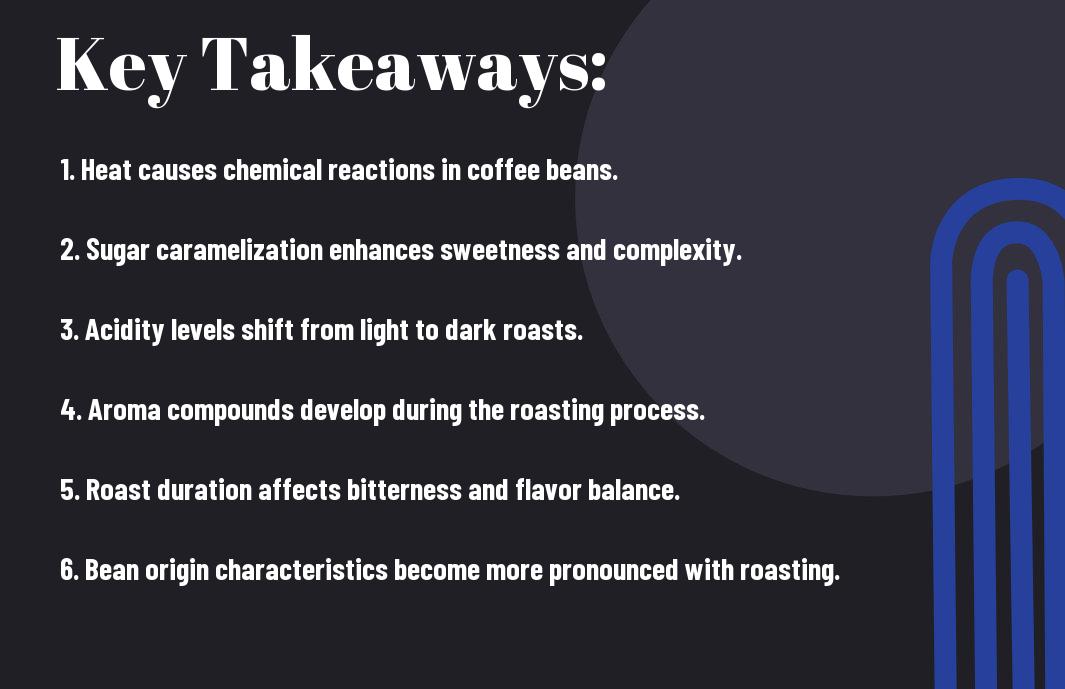You’re about to uncover the magic of coffee roasting. As you examine into the world of coffee, you’ll find that roasting is what sets your favorite brew apart. You’ll discover how high temperatures and precise timing can bring out unique flavors and aromas in your coffee beans, making each cup a delightful experience. Get ready to learn how roasting can elevate your coffee game and take your taste buds on a journey.
Key Takeaways:
- The roasting process transforms the flavor of coffee beans by bringing out their unique aromatic and flavor profiles, which are developed through the Maillard reaction, a chemical reaction between amino acids and reducing sugars.
- The degree of roast has a significant impact on the final flavor of the coffee, with lighter roasts preserving more of the coffee’s acidity and fruit notes, while darker roasts bring out more bitter and rich flavors.
- The roasting technique used can also influence the flavor of the coffee, with hot air roasting and drum roasting producing distinct flavor profiles and textural differences, highlighting the importance of roast level and roasting method in shaping the final flavor of the coffee beans.

The Roasting Process
While exploring the art of coffee roasting, you’ll find that it’s a complex process. You can learn more about how the roast you give coffee affects its flavor and discover the science behind it.
Chemical Reactions
At the heart of the roasting process, chemical reactions occur, transforming your coffee’s flavor profile. These reactions break down and recombine compounds, creating new, complex flavors.
Physical Changes
Roasting causes physical changes in your coffee beans, altering their color, density, and structure. This transformation affects the way your coffee beans interact with water, ultimately impacting the flavor in your cup.
Physical changes during roasting are dramatic, with beans expanding in size and losing their moisture. As you roast your coffee, you’ll notice the beans becoming lighter and more fragile, which can be dangerous if not handled properly. Strong flavors and aromas are developed during this process, making your coffee more flavorful and enjoyable.
Flavor Profiles
Some of the most distinct flavor profiles emerge during the roasting process, and you can expect a wide range of notes to develop, from fruity to nutty, depending on the roast level.
Light Roasts
To achieve a light roast, you’ll want to stop the roasting process early, preserving the coffee’s natural acidity and fruit notes, resulting in a bright, tea-like flavor.
Dark Roasts
At the darker end of the spectrum, you’ll find a richer, more full-bodied flavor, with notes of chocolate and caramel, as the roasting process brings out the coffee’s deep, smoky undertones.
For instance, as you explore the world of dark roasts, you’ll discover that the high temperatures used during the roasting process can sometimes produce a bitter taste, but when done correctly, the result is a smooth, velvety flavor that’s perfect for those who enjoy a strong cup of coffee, and you’ll appreciate the complex flavor profile that dark roasts have to offer.

The Role of Heat
For the transformation of coffee beans, heat plays a significant role. You will notice that as you apply heat, the beans undergo a dramatic change in flavor and aroma.
Temperature Control
Among the key factors in roasting, temperature control is vital. The following table highlights the importance of temperature:
Temperature Effect High Fast Roasting Low Slow Roasting You can see that temperature control allows you to achieve your desired roast level.
Roasting Techniques
For a perfect roast, you need to master various techniques. You will find that different techniques produce unique flavor profiles, and experimenting with them can be rewarding.
Hence, as you explore roasting techniques, you will discover that high temperatures can quickly bring out the desired flavors, but also carry the risk of burning the beans. You should be cautious and attentive to the roasting process to achieve the perfect balance of flavors and aromas, making your coffee truly exceptional.
The Impact of Roast Level
Unlike other factors, roast level has a profound impact on the flavor of your coffee beans. You can learn more about the coffee roasting process and its effects on flavor at Coffee Roasting: What Roasting Actually Does To Your Coffee, which provides valuable insights into the process.
Acidity and Body
AFTER you choose your roast level, you’ll notice changes in acidity and body. Your coffee’s acidity will decrease as the roast level increases, while the body will become fuller and more rich.
Balance and Complexity
IMPACT of roast level on balance and complexity is significant. Your coffee’s flavor profile will shift, with lighter roasts showcasing fruitier and more acidic notes, while darker roasts bring out deeper and more bitter flavors.
In fact, as you experiment with different roast levels, you’ll find that the balance and complexity of your coffee’s flavor profile are directly affected. You’ll notice that a well-balanced roast can bring out the best in your coffee, with notes of chocolate and caramel emerging in darker roasts, while lighter roasts highlight brighter and more delicate flavors. This delicate balance is what makes the roasting process an art form, and as you refine your skills, you’ll be able to coax the perfect flavor from your coffee beans.
Regional Roasting Traditions
Now, as you explore the world of coffee, you’ll discover that roasting traditions vary greatly from one region to another, shaping the flavor of your coffee beans in distinct ways.
European Styles
The traditional European approach to roasting is characterized by a lighter touch, preserving the coffee’s natural acidity and fruit notes.
American Approaches
For your taste buds, American roasting styles offer a bolder and more full-bodied experience, with a focus on smoky and caramel-like flavors.
European roasters may view American approaches as overly dark, but you’ll find that these methods can bring out deep and rich flavors in your coffee, making it a delicious choice for those who prefer a stronger cup.
The Art of Roasting
Many factors contribute to the transformation of coffee beans during roasting, and as you explore this process, you’ll discover the nuances that set great coffee apart. You’ll learn how roasting coaxes out the unique characteristics of each bean, and how it can make or break the flavor of your coffee.
Roaster’s Craft
About the time you think you’ve mastered the basics of roasting, you’ll find that there’s always more to learn. As you develop your skills, you’ll appreciate the delicate balance of time, temperature, and technique that a skilled roaster must maintain to bring out the best in your coffee beans.
Quality Control
Across the coffee industry, quality control is crucial to ensuring that every batch of beans meets the highest standards. As you evaluate the quality of your roasted coffee, you’ll look for consistent flavor and aroma, and you’ll need to be able to identify defects that can affect the taste of your coffee.
Understanding the importance of quality control, you’ll take a closer look at the roasting process, from the initial green bean selection to the final cupping and evaluation. You’ll learn to identify flavor profiles and acidity levels, and you’ll develop a keen sense of smell and taste to detect even the slightest variations in quality, which can make a significant difference in the overall flavor of your coffee, and may even pose a risk of contamination or spoilage if not done properly, ultimately affecting the safety and enjoyment of your coffee.
Final Words
So, you’ve seen how roasting transforms the flavor of coffee beans. You’ve learned that it brings out the unique characteristics of your coffee, developing its flavor and aroma. Now, you can appreciate the art of roasting and its impact on your daily cup. Your understanding of the process will enhance your coffee experience, allowing you to savor each sip with newfound appreciation.
FAQ
Q: What happens to the flavor of coffee beans during the roasting process?
A: During the roasting process, the flavor of coffee beans undergoes a significant transformation. The beans are heated to high temperatures, which causes the starches to break down and convert into sugars, resulting in the development of new flavor compounds. The roasting process can bring out notes of caramel, chocolate, and nuts, depending on the level of roast. Lighter roasts tend to preserve more of the coffee’s natural acidity and fruit notes, while darker roasts produce a richer, more bitter flavor.
Q: How does the level of roast affect the flavor of coffee beans?
A: The level of roast has a significant impact on the flavor of coffee beans. Lighter roasts, such as Light or City Roast, tend to have a brighter, more acidic flavor with notes of fruit and floral hints. Medium roasts, such as Medium or American Roast, offer a balanced flavor with a mix of acidity and body. Darker roasts, such as French or Espresso Roast, have a bold, rich flavor with deep notes of chocolate and a heavier body. The level of roast can also affect the coffee’s aroma, with lighter roasts having a more delicate aroma and darker roasts having a more intense aroma.
Q: Can the roasting process enhance or mask the natural flavors of the coffee beans?
A: The roasting process can both enhance and mask the natural flavors of the coffee beans. A skilled roaster can bring out the unique characteristics of the coffee beans, such as the fruit notes or wine-like flavors, by carefully controlling the roasting time and temperature. However, if the beans are over-roasted, the natural flavors can become masked by the bitter and smoky flavors produced during the roasting process. Conversely, under-roasted beans may not develop their full flavor potential, resulting in a bland or grassy taste. A balanced roast can enhance the natural flavors of the coffee beans, resulting in a complex and nuanced flavor profile.




